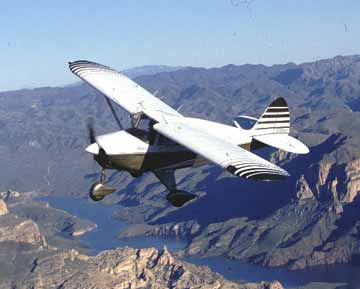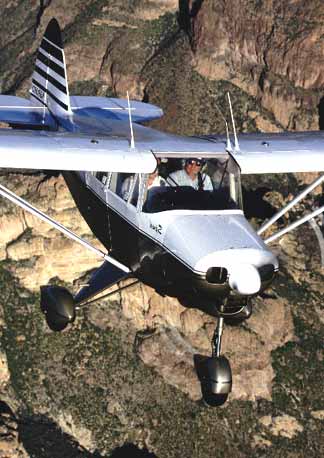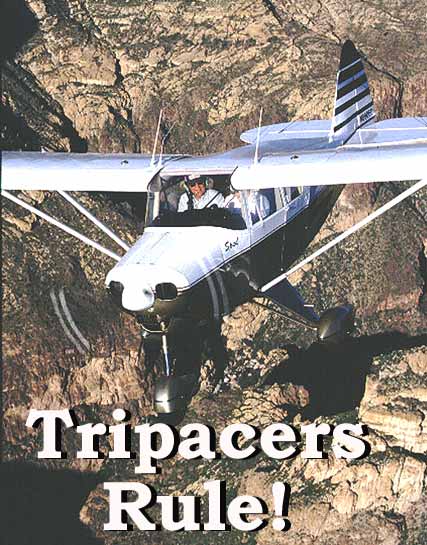|
Tri-Pacer:
Piper's Utilitarian Milk Stool
It
was July 4th, 1959 at Lincoln, Nebraska's now long-gone Union Airport.
The grass of the north-south runway stretched before me and disappeared
in the distance. There was no way I could know exactly how far away
the other end of that runway would prove to be: When Tri-Pacer N8518D
carried me off the far end on my first solo flight, the distance covered
would eventually span a life time. At one end I was a 17-year-old
kid from a small town and all that implies. At the other end I had
become a 17 year old with stars in his eyes who would never look back.
I still remember the smell of that first Tri-Pacer and, although within
the hierarchy of classic airplanes, many put the PA-22 near the bottom,
I don't and never have. And it is more than nostalgia. The Tri-Pacer,
despite its almost comically compact lines, delivers. It will do the
job and today, with nearly 8,000 having been built, 1951-1960, it
may well be one of the better bargains in four-place airplanes. It
is, however, not without its problems, chief among them being some
rather ominous AD's.
Tri-Pacers are old. Of more importance, they are made of fabric covered
steel tubing and therein lies possible problems. Steel rusts. If the
airplane has been hangared most of its life, chances are this isn't
an issue. But most haven't. The primary areas of concern are the areas
covered by the flat metal frames around the door posts, the struts,
strut fittings and the lower carry-through structure in the bottom
of the fuselage. The AD's were issued after a Tri-Pacer lost a wing.
Before buying a Tri-Pacer, have it very carefully inspected by someone
who really knows the airplane. Very few of the airplanes are in critical
condition, but a little paranoia is always a good thing.
Tri-Pacer wings are fabric over an aluminum structure and, other than
inspecting for damage and obvious corrosion, they represent no unusual
problems other than the condition of the covering.
Modern synthetic covering materials (as opposed to cotton or linen)
go under several different trade names but most are a variation of
either Dacron, a polyester, or fiberglass. Dacron materials, if kept
in a hangar are good for years and years, as long as 20 or more. Ceconite
and Razorback can go forever, which can be a disadvantage. Rag and
tube structures should be periodically opened up and inspected. On
a potential purchase, have the covering inspected, again by a pro,
as it can cost every bit of $10,000 to have a decent covering job
done (Ed. Note: that would $15-$19K in 2006).
| |
 |
| |
Although the Tripacer's wings are
short, it gets off surprisingly well. |
One of the reasons the Tri-Pacer suffers so much in the eyes of
high-brow purists is its landing gear. The original PA-20 Pacer,
from which the Tri-Pacer descended, was a cute-as-a-bug airplane
which, unfortunately demanded some attention on takeoff and landing.
As soon as Piper hung a nose wheel under it, sales sky rocketed
as the airplane became brain-dead simple to takeoff and land. Unfortunately
the cost paid was that it earned its "milk stool" moniker
because of the near-tripod appearance of the landing gear.
What many of the purists fail to concede however is how well the
airplane performs. If you compare POH numbers you'll see a 1958
160 hp Tri-Pacer will cruise within 4 knots of a similarly powered
1986 172P, stalls four knots slower, out climbs it, lands shorter
and has a much higher service ceiling. It does give up some distance
in the takeoff roll and has 50 pounds less useful load and 7 gallons
less fuel, but it also costs about a third as much.
The foregoing is all on paper. The big question is: How does the
Tri-Pacer fly in the real world? To find that out we contacted Stan
Watkins, Executive Director of the Short Wing Piper Club Foundation,
who bases his PA-22-160 at Scottsdale, AZ.
Stan's airplane, Spud, came to live with him in 1990 and it was,
in his words "...ugly as homemade sin..." He had the airplane
painted in Ditzler Durathane and turned the interior over to Paul
Sanchez at Elite Interiors in Portland, Oregon who did it up in
leather. At the same time, Sanchez completely rebuilt the seats
for comfort and Stan says the difference is remarkable.
About the name "Spud." The Watkins family initially referred
to Stan's new purchase as a flying potato. More specifically, an
ugly little spud potato. The name stuck.
One sunny afternoon, Stan taxiied up, put his wife Cheryl, who learned
to fly in the airplane, in the back seat, and the three of us took
Spud aviating.
The Tri-Pacer is one of the few airplanes (I can't actually think
of another) that has a right door for the front seat and a left
door for the rear seat. The upside to that is the rear passengers
have their own door. The downside is the pilot has to be in before
the front passenger. Fortunately, boarding through either door is
actually easier than getting in a 172.
Once inside, the smallish size of the cockpit is exaggerated by
a window area that is smaller than on modern aircraft. For someone
coming out of a four-place Cessna, for example, the cabin is going
to feel dark and claustrophobic. Fortunately, that feeling goes
away in minutes.
The first test while flying a Tri-Pacer is figuring out how to start
it. If a person comes to the breed with no prior knowledge his chances
of getting it fired up are absolutely zero because they'll never
find the master switch and starter button. Unless the airplane has
been converted, the pilot has to reach between his legs and under
the bottom of the seat for both switches.
With the engine cranked, we were ready to taxi. The nose wheel steering
feels pretty much like any other however some people find the lack
of individual brake pedals a little disconcerting. A lever, often
called a "Johnson Bar" hangs from under the panel and
activates both brakes at once. In reality individual brakes aren't
needed for tight maneuvering, as the turn radius with that narrow
gear is so tight the inside wing tip is nearly tracking backwards.
Also, the wings are so short, it'll fit in some awfully tight holes
|
Some Random Personal Thoughts
At this stage of the game I've been flying for forty-nine
years (an unbelievable thought). During that period of time
I've owned a number of airplanes ranging from Cessna 195's
to Clipped Cubs to P-51 Mustangs. Through it all, there has
been this underlying thought, "I ought to just buy a
Tripacer and be done with it." I've always regarded the
airplane as being one of the most practical, and certainly
one of the most cost-efficient ways of getting around. So,
at some point, I'll probably wind up with one. They make too
much sense not to.
|
|
While taxing, I was reminded that Tri-Pacer's came with two basic
instrument panel configurations. The early airplanes had the "low
panel" and have much better visibility over the nose than the
later ones but are cramped for radio space. "Spud" has the
high top panel and is IFR equipped, although Stan seldom uses it as
such.
On takeoff, the 160 hp Lycoming tugged us along with respectable acceleration
which was nice. Tri-Pacer's come with engines as small as 125 hp (fairly
rare) with 135 hp and 150 hp being by far the most common. The 160
hp was on most of the later airplanes and the extra power is very
noticeable. The small engine airplanes are really too under powered
to give solid performance at gross weight. This is especially true
out west. With only two people on board, however, they fly just fine.
| |
 |
| |
The 150/160 hp airplanes are much
better suited for carrying four people. Especially at higher
density altitudes. |
Keeping Spud on the centerline during takeoff was an absolute no brainer
and, even though there was a slight crosswind, I don't remember using
my feet for anything. Stan advised rotating cleanly off the ground
at 65 mph or when thenose felt light. This too was a no-brainer. A
gentle tug at the right moment and it stepped into the air with no
hesitation or tendency to settle back on.
I purposely kept a shallow attitude letting the speed build to 80
mph which Stan said was a good speed at our weight. The airplane was
quite speed stable and willing to sit on 80 mph with only a
little trimming. It was the trimming that was a problem, albeit, a
minor one. The overhead trim crank takes a little getting used to,
if only to remember which direction to turn it. 100% of the time I
turned it the wrong way first, even though Stan told me counter-clockwise
was down. Or was it up?
As the airplane settled into a climb, the ASI glued itself to 900
fpm and stayed there until we leveled out at altitude. Considering
that we were three people and full tanks that's not bad for an airplane
everyone makes fun of.
When we leveled out in cruise Stan commented that he really babies
his airplane and purposely uses lower than normal power settings,
around 2300 rpm, for cruise. Also, his prop is a compromise between
cruise and climb. This power setting gave us about 115 mph indicated
which is what he says he uses for flight planning purposes, but almost
always beats that number. Other Tri-Pacer owners report that most
will true out at 120-125 mph at 2450 rpm depending on the prop.
Considering that one of the integral parts of the airplane's unearned
reputation is its short wings and its supposed tendency to imitate
a hockey puck, the stalls are hardly worthy of the name. In any configuration,
gradually pulling the yoke to the stop produces nothing but a soft
mushing and the VSI needle sagging to something around 500 rpm. It's
nearly impossible to get it to break short of a full power, accelerated
stall.
People tend to forget that the Tri-Pacer is a product of the time
when they were trying to engineer required-skill out of the pilot
equation. The Ercoupe was the extreme example in that it eliminated
rudder pedals completely. The Tri-Pacer didn't go that far, but it
did have spring interconnects between the aileron and the rudder so
you could fly it with your feet flat on the floor and still have the
ball centered. It had been some time since I'd flown a stock Tri-Pacer
and I was surprised to find the interconnect wasn't as strong as I
remembered. While rocking the wings with the yoke did cause a little
automated rudder input, it was easily over come to induce a slip,
if wanted. Also, the roll rate is quite a bit higher than I remembered
and higher than a C-172, which I liked.
While cruising around, the visibility is perfectly fine, although
the illusion is that it's less than something like a 172 because everything
in the cockpit is a little closer together. However, if sight angles
were measured, I'd be willing to bet there really isn't that much
difference, if any.
One thing about the Tri-Pacer legend that is absolutely true is its
glide ratio. Notice I said glide ratio, not rate of descent. Yes,
it's coming down a little faster than some airplanes, but it's coming
down a lot steeper than most. Its power off angle of descent with
only one notch of flaps is about the same as a Cessna with the boards
all the way out. This much I remembered and planned the approaches
accordingly.
I brought the power down to 1500 rpm and set up 80 mph as an initial
number intending on going down to 70-75 over the fence. As the runway
numbers started moving down the windshield indicating we were high,
I eased the power to idle and we immediately started sliding down
towards the numbers. We only had 10° of flaps out and it was obvious
we didn't need any more. Stan says he seldom uses full flaps for anything.
I was using the 1000 foot markers as my touch down point and they
stayed rigid in the windshield as we fell at the ground. To a Cessna
pilot, the angle and rate of descent may look high but I think they'd
also sense the rock steady feeling of the airplane in that situation.
There's no moving around or fidgeting. The airplane feels as solid
as a cement block. Right at the bottom, as I started to flair, I cheated
by squeaking on just a touch of power as insurance and bled it back
off as I got deeper into the flair.
The mains touched with an authoritative "thunk" and stayed
there. I was able to hold the nose off only briefly before it too
came down. Then it was carb heat off, flaps up and let's do it again.
I really enjoyed Spud. In fact, I enjoyed just about everything about
the airplane. I'm now convinced that most Tri-Pacer fanatics aren't
bothered at all by the airplane's less than glamorous reputation.
That helps keep the prices down and that undoubtedly suits them just
fine.
|
| |
|

